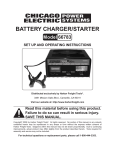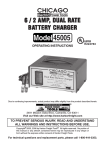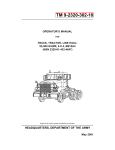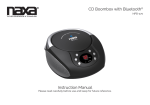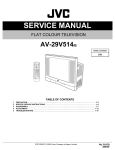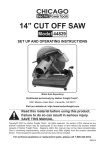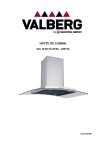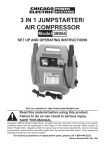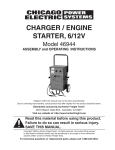Download CHICAGO 45005 Operating instructions
Transcript
6 / 2 AMP, DUAL RATE BATTERY CHARGER 45005 Set up And Operating Instructions Distributed exclusively by Harbor Freight Tools®. 3491 Mission Oaks Blvd., Camarillo, CA 93011 Visit our website at: http://www.harborfreight.com Read this material before using this product. Failure to do so can result in serious injury. Save this manual. Copyright© 2008 by Harbor Freight Tools®. All rights reserved. No portion of this manual or any artwork contained herein may be reproduced in any shape or form without the express written consent of Harbor Freight Tools. Diagrams within this manual may not be drawn proportionally. Due to continuing improvements, actual product may differ slightly from the product described herein. Tools required for assembly and service may not be included. For technical questions or replacement parts, please call 1-800-444-3353. Revised manual 08j, 09f Specifications Input 120 V~, 60 Hz, 1.3 A Output Power 6* & 2* A at 12 VDC; 6* A at 6 VDC Battery Cables 6’ 7”; 18 AWG E224783 Line Cord 6’ 6” long; 3-prong plug Features Ammeter Self-resetting circuit breaker *Amperage is only present while connected to a battery. You will need the manual for the safety warnings and precautions, assembly instructions, operating and maintenance procedures, parts list and diagram. Keep your invoice with this manual. Write the invoice number on the inside of the front cover. Keep the manual and invoice in a safe and dry place for future reference. SAVE THESE WARNINGS WARNING! READ AND UNDERSTAND ALL INSTRUCTIONS Failure to follow all instructions listed below may result in electric shock, fire, and/or serious injury. 3. Keep bystanders, children, and visitors away while operating equipment. Distractions can cause you to lose control. ELECTRICAL SAFETY 1. Grounded equipment must be plugged into an outlet properly installed and grounded in accordance with all codes and ordinances. Never remove the grounding prong or modify the plug in any way. Do not use any adapter plugs. Check with a qualified electrician if you are in doubt as to whether the outlet is properly grounded. If the equipment should electrically malfunction or break down, grounding provides a low resistance path to carry electricity away from the user. 2. Double insulated equipment is equipped with a polarized plug WORK AREA (one blade is wider than the other). This plug will fit in a polarized out1. Keep your work area clean and well let only one way. If the plug does lit. Cluttered benches and dark areas not fit fully in the outlet, reverse the invite accidents. plug. If it still does not fit, contact 2. Do not operate equipment in exa qualified electrician to install a plosive atmospheres, such as in polarized outlet. Do not change the presence of flammable liquids, the plug in any way. Double insulagases, or dust. Equipment creates tion eliminates the need for the sparks which may ignite the dust or three wire grounded power cord and fumes. grounded power supply system. SKU 45005 For technical questions, please call 1-800-444-3353. REV 05l Page 2 3. Avoid body contact with grounded surfaces such as pipes, radiators, ranges, and refrigerators. There is an increased risk of electric shock if your body is grounded. 4. Do not expose equipment to rain or wet conditions. Water entering equipment will increase the risk of electric shock. ANSI approved safety goggles and a dust mask/respirator when using or performing maintenance on this equipment. EQUIPMENT USE AND CARE 1. Do not force the equipment. Use the correct equipment for your application. The correct equipment will do the job better and safer at the rate 5. Do not abuse the Power Cord. for which it is designed. Do not use Never use the Power Cord to carry the equipment for a purpose for which the equipment or pull the Plug from it is not intended. an outlet. Keep the Power Cord away from heat, oil, sharp edges, 2. Do not use the equipment if the or moving parts. Replace damaged Power Switch does not turn it on Power Cords immediately. Damor off. Any equipment that cannot be aged Power Cords increase the risk of controlled with the Power Switch is electric shock. dangerous and must be replaced. 6. When operating equipment outside, use an outdoor extension cord marked “W-A” or “W”. These extension cords are rated for outdoor use, and reduce the risk of electric shock. PERSONAL SAFETY 3. Disconnect the Power Cord Plug from the power source before making any adjustments, changing accessories, or storing the equipment. Such preventive safety measures reduce the risk of starting the equipment accidentally. Always unplug the equipment from its electrical outlet before performing any inspection, maintenance, or cleaning procedures. 1. Stay alert. Watch what you are doing, and use common sense when operating equipment. Do not use equipment while tired or under 4. Store idle equipment out of reach the influence of drugs, alcohol, or of children and other untrained medication. A moment of inattention persons. Equipment is dangerous in while operating equipment may result the hands of untrained users. in serious personal injury. 5. Maintain equipment with care. Do 2. Avoid accidental starting. Be sure not use damaged equipment. Tag the Power Switch is off before damaged equipment “Do not use” plugging in. Plugging in equipment until repaired. with the Power Switch on, invites ac6. Check for breakage of parts and cidents. any other condition that may affect 3. Use safety equipment. Always the equipment’s operation. If damwear eye protection. Dust mask, aged, have the equipment serviced nonskid safety shoes, hard hat, or before using. Many accidents are hearing protection must be used for caused by poorly maintained equipappropriate conditions. Always wear ment. SKU 45005 For technical questions, please call 1-800-444-3353. Page 3 7. Use only accessories that are rec- 5. Place the Battery Charger as far away ommended by the manufacturer for from the battery as possible during your model. Accessories that may charging. be suitable for one piece of equipment 6. Do not attempt to charge a battery may become hazardous when used with frozen battery fluid. on another piece of equipment. 7. Do not drip any battery fluids in or SERVICE around the Battery Charger. 1. Equipment service must be performed only by qualified repair personnel. Service or maintenance performed by unqualified personnel could result in a risk of injury. 8. Do not touch the Battery Charger cable clamps together when the charger is plugged in; touching the cable clamps together may cause personal injury. 2. When servicing equipment, use only identical replacement parts. Follow instructions in the “Inspection, Maintenance, And Cleaning” section of this manual. Use of unauthorized parts or failure to follow maintenance instructions may create a risk of electric shock or injury. 9. Do not touch eyes after working with a lead-acid battery. Wash hands thoroughly with soap and water. If battery fluids contact the skin, face, or eyes, immediately flush with plenty of fresh water. Then, contact a doctor. Additional Battery Charger Safety Precautions 1. This Battery Charger must only be used on lead-acid, rechargeable type batteries. Do not use this Battery Charger to charge household, drycell batteries. Dry-cell batteries may explode causing personal injury or property damage. 2. Do not use the Battery Charger as a low voltage system power supply except in automotive applications. 3. Do not try to start the automobile engine when the Battery Charger is connected to the battery. It may damage the unit. 10. Do not smoke around a charging battery. 11. Make all Cable Clamp connections before plugging in the Battery Charger. 12. Remove all metal objects (including tools and other personal objects, i.e., watch) from around the battery being charged. 13. Battery must be vented and maintenance-free (non-fillable) battery. Vents must be clear and dirt free. 14. Use this product in accordance with the battery’s and vehicle’s instruction manual recommendations, safety warnings and charging instructions. 15. Do not leave Battery Charger unattended. 4. Charge a lead-acid battery only in 16. Batteries can explode under certain a well-ventilated area as explosive conditions; excessive heat and/or gases may be produced during chargpoor ventilation can cause explosive ing. gas buildup and battery explosion. Surges in electrical power supSKU 45005 For technical questions, please call 1-800-444-3353. Page 4 ply could possibly cause battery explosion. Battery Charger should be plugged into a surge protection device. Grounded Tools: Tools with Three Prong Plugs 17. People with pacemakers should consult their physician(s) before use. Electromagnetic fields in close proximity to heart pacemaker could cause pacemaker interference or pacemaker failure. 18. WARNING: Handling the cord on this product will expose you to lead, a chemical known to the State of California to cause cancer, and birth defects or other reproductive harm. Wash hands after handling. (California Health & Safety Code § 25249.5, et seq.) Grounding 1. Tools marked with “Grounding Required” have a three wire cord and three prong grounding plug. The plug must be connected to a properly grounded outlet. If the tool should electrically malfunction or break down, grounding provides a low resistance path to carry electricity away from the user, reducing the risk of electric shock. (See 3-Prong Plug and Outlet.) Improperly connecting the grounding wire can result in 2. The grounding prong in the plug is electric shock. connected through the green wire in Check with a qualified side the cord to the grounding system electrician if you are in doubt in the tool. The green wire in the cord as to whether the outlet is must be the only wire connected to properly grounded. Do not the tool’s grounding system and must modify the power cord plug never be attached to an electrically provided with the tool. Never “live” terminal. (See 3-Prong Plug remove the grounding prong and Outlet.) from the plug. Do not use the tool if the power cord or plug 3. The tool must be plugged into an is damaged. If damaged, have appropriate outlet, properly installed it repaired by a service facility and grounded in accordance with all before use. If the plug will not codes and ordinances. The plug and fit the outlet, have a proper outlet should look like those in the outlet installed by a qualified preceding illustration. (See 3-Prong electrician. Plug and Outlet.) Extension Cords 1. Grounded tools require a three wire extension cord. Double Insulated SKU 45005 For technical questions, please call 1-800-444-3353. REV 07g, 08j Page 5 3. The smaller the gauge number of the wire, the greater the capacity of the cord. For example, a 14 gauge cord can carry a higher current than a 16 gauge cord. (See Table A.) 0 – 2.0 2.1 – 3.4 3.5 – 5.0 5.1 – 7.0 7.1 – 12.0 12.1 – 16.0 16.1 – 20.0 TABLE A 4. When using more than one extension cord to make up the total length, make sure each cord contains at least the minimum wire size required. (See Table A.) 5. If you are using one extension cord for more than one tool, add the nameplate amperes and use the sum to determine the required minimum cord size. (See Table A.) 6. If you are using an extension cord outdoors, make sure it is marked with the suffix “W-A” (“W” in Canada) to indicate it is acceptable for outdoor use. 150’ 100’ 75’ 50’ 2. As the distance from the supply outlet increases, you must use a heavier gauge extension cord. Using extension cords with inadequately sized wire causes a serious drop in voltage, resulting in loss of power and possible tool damage. (See Table A.) RECOMMENDED MINIMUM WIRE GAUGE FOR EXTENSION CORDS* (120/240 VOLT) EXTENSION CORD NAMEPLATE LENGTH AMPERES (at full load) 25’ tools can use either a two or three wire extension cord. 18 18 18 18 16 18 18 18 16 14 18 18 16 14 12 18 16 14 12 12 18 14 12 10 14 12 10 12 10 * Based on limiting the line voltage drop to five volts at 150% of the rated amperes. Symbology Double Insulated Canadian Standards Association Underwriters Laboratories, Inc. V~ A Volts Alternating Current Amperes No Load Revolutions per n0 xxxx/min. Minute (RPM) 7. Make sure the extension cord is properly wired and in good electrical condition. Always replace a damaged extension cord or have it repaired by a qualified electrician before using it. 8. Protect the extension cords from sharp objects, excessive heat, and damp or wet areas. SKU 45005 For technical questions, please call 1-800-444-3353. Page 6 Unpacking When unpacking, make sure that the Battery Charger is intact and undamaged. If any parts are missing or broken, please call Harbor Freight Tools at the number on the cover of this manual. Operation 1. Place the Battery Charger about six feet from the battery being charged. Note: This Battery Charger is NOT for use on DEAD or DAMAGED batteries. 2. To CHARGE A BATTERY, verify that the ignition is off, remove vehicle’s cables from battery, then connect the positive (Red with +) Cable Clamp to the positive (+ or P) terminal of the battery. If necessary, clean the battery terminals. Wiggle the Cable Clamp on the battery terminal to get a good connection. 3. Connect the negative (Black with –) to the negative battery terminal. Note: Battery clamps must be connected properly or the battery charger will not operate and charge battery. There is no voltage at the clamps when disconnected from the battery. Battery Charging Switch Setting Voltage Time 12 V Right 6 to 8 hours (12 V, 6 A) 12 V Center 3 to 8 hours (12 V, 2 A) 6V Left 6 to 8 hours (6 V, 6 A) Typical Battery Uses Vehicles, machinery with large engines Motorcycles, snowmobiles, small engines. For batteries rated at 28 Ah. Vehicles, machinery with large engines using 6 volt battery 4. Set the Battery Charger switch to the proper setting for the type battery being charged. Refer to the table above. Mode Switch 5. With the Battery Clamps in place, and the Mode Switch correctly set, plug the 3-prong line cord into a grounded electrical outlet or extension cord. SKU 45005 For technical questions, please call 1-800-444-3353. REV 09d Page 7 6. The Battery Charger is now supplying charging current to the battery. View the Ammeter to see the amount of charging current. % Charge Scale Fully Charged Charging at full 2 amps Charging at full 6 amps The ammeter displays the amount of current draw of the battery. As the battery charges, it draws less current. The ammeter indicator moves down as the battery charges. When its reaches the green area of the ammeter, the battery is charged. When the charge setting is 12 volts, 6 amps, the percentage (%) charge scale can be read as an indication of the charge. 7. For 12V settings only: When the battery is fully charged, the battery charger will cut-off the charging current and switches to float charge maintenance mode. While in the float charge maintenance mode, the charger will cycle ON and OFF between preset cut-in and cut-off voltages to prevent overcharging and to compensate for battery self-discharge. Note: When set in 6 volt mode, the Battery Charger will not automatically switch to standby mode; it must be manually turned off. 8. Remove the negative (black) Cable Clamp from the battery. 9. Remove the positive (red) Cable Clamp from the battery. SKU 45005 For technical questions, please call 1-800-444-3353. REV 09f Page 8 Maintenance 1. Using a clean cloth, wipe the Cable Clamps and charger of all grease and dirt. 2. Coil all cables. 3. Store the Battery Charger in a clean and dry location. 4. If any cable insulation becomes cracked and exposes copper wire, have it repaired or replaced by a qualified technician. Troubleshooting Problem Maximum ammeter reading No ammeter reading Possible Causes Defective battery 1. No power to charger 2. Charging current not to full output Ammeter needle moves up to full charge, then drops to zero. Makes clicking noise. Likely Solutions Check and/or replace battery 3. 1. 2. 1. 2. 3. 1. Check power cable and outlet connections Battery cable clamps not connected to 2. Clean battery terminals and reset battery properly cable clamps Defective battery 3. Check and/or replace battery Battery is partially charged 1. Continue charging Defective battery, will not hold full 2. Check and/or replace battery charge Battery is completely dead 1. Continue charging battery. Charger will continue to reset itself until the battery charge reaches a chargeable level. 2. Check and/or replace battery Defective battery 3. Wait until charger automatically Charger is resetting itself after circuit resets itself. breaker overload Follow all safety precautions whenever diagnosing or servicing the tool. Disconnect power supply before service. Note: No replacement parts are available for the Battery Charger. SKU 45005 For technical questions, please call 1-800-444-3353. Page 9 LIMITED 90 DAY WARRANTY Harbor Freight Tools Co. makes every effort to assure that its products meet high quality and durability standards, and warrants to the original purchaser that this product is free from defects in materials and workmanship for the period of 90 days from the date of purchase. This warranty does not apply to damage due directly or indirectly, to misuse, abuse, negligence or accidents, repairs or alterations outside our facilities, criminal activity, improper installation, normal wear and tear, or to lack of maintenance. We shall in no event be liable for death, injuries to persons or property, or for incidental, contingent, special or consequential damages arising from the use of our product. Some states do not allow the exclusion or limitation of incidental or consequential damages, so the above limitation of exclusion may not apply to you. This warranty is expressly in lieu of all other warranties, express or implied, including the warranties of merchantability and fitness. To take advantage of this warranty, the product or part must be returned to us with transportation charges prepaid. Proof of purchase date and an explanation of the complaint must accompany the merchandise. If our inspection verifies the defect, we will either repair or replace the product at our election or we may elect to refund the purchase price if we cannot readily and quickly provide you with a replacement. We will return repaired products at our expense, but if we determine there is no defect, or that the defect resulted from causes not within the scope of our warranty, then you must bear the cost of returning the product. This warranty gives you specific legal rights and you may also have other rights which vary from state to state. 3491 Mission Oaks Blvd. • PO Box 6009 • Camarillo, CA 93011 • (800) 444-3353 SKU 45005 For technical questions, please call 1-800-444-3353. REV 08d Page 10










